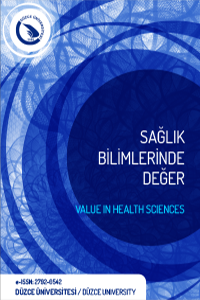Piterjiumlu Hastalarda Seruloplazmin, Albümin, İskemi-Modifiye Albümin ve Miyeloperoksidaz Düzeylerinin Belirlenmesi
Amaç: Biyobelirteçler vücuttaki birçok hastalığın varlığının ya da ciddiyetinin ölçülebilir bir göstergesidir. Öte yandan yapılan birçok klinik çalışmaya rağmen yaygın bir göz hastalığı olan konjonktival piterjium etiyopatojenezi tam olarak aydınlatılamamıştır. Fakat multifaktöriyel olduğu düşünülen etiyolojisinin bazı biyobelirteçlerle olan sıkı ilişkisi de iyi bilinmektedir. Bu çalışmada piterjium hastalığı ile serum seruloplazmin, albümin, iskemi-modifiye albümin ve miyeloperoksidaz düzeyleri arasındaki ilişkinin incelenmesi amaçlanmıştır. Gereç ve Yöntemler: Çalışmaya konjonktival piterjiumu olan 40 hasta ve yaş-cinsiyet uyumlu 40 sağlıklı gönüllü dahil edildi. Tüm olgulara detaylı oftalmolojik muayene yapıldı. Ayrıca piterjium grubundaki olgularda piterjium derecelendirilmesi yapıldı. Tüm olgulardan serum örnekleri toplandı ve seruloplazmin, albümin, iskemi-modifiye albümin ve miyeloperoksidaz düzeylerine bakıldı. İstatistiksel analizde Ki-kare testi, Bağımsız örneklemler t-testi, Mann-Whitney U testi ve Spearman korelasyon analizi kullanıldı. P<0,05 düzeyi istatistiksel olarak anlamlı kabul edildi.Bulgular: Gruplar demografik açıdan benzerdi. Gruplar arasında seruloplazmin, albümin, iskemi-modifiye albümin ve miyeloperoksidaz düzeyleri açısından anlamlı fark saptanmadı (sırasıyla P=0,762 P=0,572 P=0,202 ve P=0,176). Piterjium grubunda korelasyon testinde albümin düzeyleri ile piterjium derecesi arasında negatif ilişki olduğu görüldü (P=0,011). Sonuç: Konjonktival piterjium ile serum seruloplazmin, albümin, iskemi-modifiye albümin ve miyeloperoksidaz düzeyleri arasında istatistiksel anlamlı bir ilişki görülmemiştir. Bununla birlikte, albümin düzeyleri ile piterjium derecesi arasındaki negatif ilişki geniş hasta gruplarıyla yapılacak ileri randomize çalışmalara ihtiyaç olduğunu düşündürmektedir.
Anahtar Kelimeler:
Biyobelirteçler, inflamasyon, konjonktiva, piterjium
Determination of Ceruloplasmin, Albumin, Ischemia-Modified Albumin and Myeloperoxidase Levels in Patients with Pterygium
Aim: Biomarkers are a measurable indicator of the presence or severity of many diseases in the body. On the other hand, despite many clinical studies, the etiopathogenesis of conjunctival pterygium which is a common eye disease has not been fully clarified. However, it is well known that the etiology, which is thought to be multifactorial, is closely related to some biomarkers. In this study, we aimed to investigate the relationship between pterygium and serum ceruloplasmin, albumin, ischemia-modified albumin and myeloperoxidase levels.Materials and Methods: Forty patients with conjunctival pterygium and 40 age and sex-matched voluntary control subjects were included in the study. All patients underwent detailed ophthalmological examination. Pterygium was graded in pterygium group. Serum samples were obtained from all subjects and ceruloplasmin, albumin, ischemia-modified albumin and myeloperoxidase levels were determined. The statistical assessment was performed using Chi-square test, Independent samples t-test, Mann-Whitney U test and Spearman’s correlation analysis. P<0.05 was considered as statistically significant.Results: The groups were similar in terms of demographic parameters. There were no statistically significant difference between groups with regards to the level of ceruloplasmin, albumin, ischemia-modified albumin and myeloperoxidase (P=0.762 P=0.572 P=0.202 and P=0.176 respectively). A negative correlation was found between albumin levels and grade of pterygium in the pterygium group (P=0.011). Conclusion: No statistically significant relationship between conjunctival pterygium and serum ceruloplasmin, albumin, ischemia-modified albumin and myeloperoxidase levels was observed. However, the negative relationship between albumin levels and grade of pterygium suggests that further randomized trials with large patient groups are needed.
Keywords:
Biomarkers, conjunctiva, inflammation, pterygium,
___
- 1. Pierrakos C, Vincent JL. Sepsis biomarkers: a review. Crit Care. 2010; 14(1): R15. doi: 10.1186/cc8872.
- 2. Aronson JK, Ferner RE. Biomarkers-a general review. Curr Protoc Pharmacol. 2017; 76(1): 9.23.1-9.23.17. doi: 10.1002/cpph.19.
- 3. Liu CH, Abrams ND, Carrick DM, Chander P, Dwyer J, Hamlet MRJ, et al. Biomarkers of chronic inflammation in disease development and prevention: challenges and opportunities. Nat Immunol. 2017; 18(11): 1175-80. doi: 10.1038/ni.3828.
- 4. Arenas de Larriva AP, Alonso A, Norby FL, Roetker NS, Folsom AR. Circulating ceruloplasmin, ceruloplasmin-associated genes and the incidence of venous thromboembolism in the atherosclerosis risk in communities study. J Thromb Haemost. 2019; 17(5): 818-26. doi: 10.1111/jth.14420.
- 5. Mishra B, Pandey S, Niraula SR, Rai BK, Karki P, Baral N, et al. Utility of ischemia modified albumin as an early marker for diagnosis of acute coronary syndrome. J Nepal Health Res Counc. 2018; 16(1): 16-21.
- 6. Nauseef WM. Biosynthesis of human myeloperoxidase. Arch Biochem Biophys. 2018; 642: 1-9. doi: 10.1016/j.abb.2018.02.001.
- 7. Malozhen SA, Trufanov SV, Krakhmaleva DA. Pterygium: etiology, pathogenesis, treatment. Vestn Oftalmol. 2017; 133(5): 76-83. doi: 10.17116/oftalma2017133576-83.
- 8. John-Aryankalayil M, Dushku N, Jaworski CJ, Cox CA, Schultz G, Smith JA, et al. Microarray and protein analysis of human pterygium. Mol Vis. 2006; 12: 55-64.
- 9. Young AL, Cao D, Chu WK, Ng TK, Yip YWY, Jhanji V, et al. The evolving story of pterygium. Cornea. 2018; 37(Suppl 1): S55-S57. doi: 10.1097/ICO.0000000000001744.
- 10. Kanski JJ. Clinical ophthalmology. A systematic approach. 6th ed. Philadelphia, PA, Pennsylvania: Butterworth- Heinemann; 2007.
- 11. Wanzeler ACV, Barbosa IAF, Duarte B, Borges D, Barbosa EB, Kamiji D, et al. Mechanisms and biomarker candidates in pterygium development. Arq Bras Oftalmol. 2019; 82(6): 528-36. pii: S0004-27492019005013105. doi:10.5935/0004-2749.20190103.
- 12. Lluch S, Julio G, Pujol P, Merindano D. What biomarkers explain about pterygium OCT pattern. Graefes Arch Clin Exp Ophthalmol. 2016; 254(1): 143-8. doi: 10.1007/s00417-015-3186-9.
- 13. Tiong KI, Mohd Zahidin AZ, Sumugam SKA, Uchang J, Mohd Isa HD. Evaluation of interleukin-17 and interleukin-23 in pterygium: immunohistochemistry study. Asia Pac J Ophthalmol (Phila). 2017; 6(5): 403-6. doi: 10.22608/APO.2017134.
- 14. Josifovska N, Szabó DJ, Nagymihály R, Veréb Z, Facskó A, Eriksen K, et al. Cultivation and characterization of pterygium as an ex vivo study model for disease and therapy. Cont Lens Anterior Eye. 2017; 40(5): 283-92. doi: 10.1016/j.clae.2017.04.002.
- 15. Ljubojević V, Gajanin R, Amidzić L, Vujković Z. The expression and significance of p53 protein and Ki-67 protein in pterygium. Vojnosanit Pregl. 2016; 73(1): 16-20.
- 16. Livezeanu C, Crăiţoiu MM, Mănescu R, Mocanu C, Crăiţoiu S. Angiogenesis in the pathogenesis of pterygium. Rom J Morphol Embryol. 2011; 52(3): 837-44.
- 17. Perra MT, Maxia C, Zucca I, Piras F, Sirigu P. Immunohistochemical study of human pterygium. Histol Histopathol. 2002; 17(1): 139-49. doi:10.14670/HH-17.139.
- Yayın Aralığı: Yılda 3 Sayı
- Başlangıç: 2022
- Yayıncı: Düzce Üniversitesi
Sayıdaki Diğer Makaleler
Obezite ile Diş Çürüğü ve Dental Erozyon Arasındaki İlişkilerin Değerlendirilmesi
